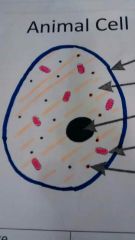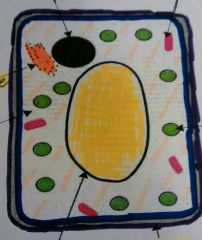![]()
![]()
![]()
Use LEFT and RIGHT arrow keys to navigate between flashcards;
Use UP and DOWN arrow keys to flip the card;
H to show hint;
A reads text to speech;
34 Cards in this Set
- Front
- Back

Name the Parts of the animal cell? |
Cell membrane, Cytoplasm, Mitochondria, Nucleus, Ribosomes. |
|

Name the Parts of the plant cell? |
Nucleus, Vacuole, Mitochondria, Chloroplast, Cell Membrane, Cell Wall, Ribosomes, Cytoplasm. |
|
|
What is the Cell Membrane? |
A selectively permeable outer layer, controls what goes in and out of the Cell. |
|
|
Describe the Cytoplasm |
Mainly made of water and salts and sugars, where chemical reactions take place. |
|
|
What does the Nucleus do? |
It controls the cells activities. |
|
|
What does the Mitochondrion do? |
It's the sit of energy production (respiration) |
|
|
What's the job of the Ribosome? |
Found in the cytoplasm and is where protein synthesis takes place. |
|
|
What does the Cell Wall do? |
Strong and flexible. Made from cellulose. Gives the Cell support. |
|
|
The Vacuole does what job? |
Store what inside the Cell. |
|
|
What does the Chloroplasts do? |
Contains chlorophyll. Where photosynthesis takes place. |
|
|
What are the Parts of cells called? |
Organelles |
|
|
What is osmosis? |
The diffusion of water from an area of high concentration to low concentration across a selectively permeable membrane. |
|
|
What is a cell made up of? |
99% water, 1% sugar and salt. |
|
|
What does turgid mean? |
The Cell is full of water |
|
|
What does plasmolysed mean? |
The process of extreme water loss in a plant cell. |
|
|
What will happen to an animal cell in a pure water solution? |
They will burst and die |
|
|
What are cell membranes made out of? |
Proteins and phospholipids |
|
|
What does DNA carry the information to make? |
Protiens |
|
|
What are the bases in DNA? |
A, C, T, G |
|
|
What pairs of bases always go together? |
A+T and G+C |
|
|
What is the shape of DNA? |
Double helix |
|
|
What is mRNA? |
Messenger RNA, a copy of DNA |
|
|
What is genetic engineering? |
The transfer of DNA from one organism to another |
|
|
What are enzymes? |
Biological catalysts, made by all living cells |
|
|
What happens to enzymes during chemical reactions? |
They speed them up, are unchanged and always produce the same products. |
|
|
What is the name of the conditions that enzymes work best at? |
Optimum conditions |
|
|
What effects enzymes? |
pH and temperature |
|
|
What happens when an enzyme is denatured? |
It's shape changes, therefore its active site no longer fits with the substrate |
|
|
What is the active site of an enzyme? |
The place that binds with the substrate and reacts |
|
|
What does "enzymes are specific" mean? |
They only react with one substrate |
|
|
What is ATP? |
Adenesine Triphosphate |
|
|
What is the word equation of aerobic respiration in animals? |
Glucose + oxygen = ATP + Carbon Dioxide + Water |
|
|
Where does the first stage of aerobic respiration in animals take place? |
Cytoplasm |
|
|
Where does the second stage of aerobic respiration in animals take place? |
Mitochondria |

